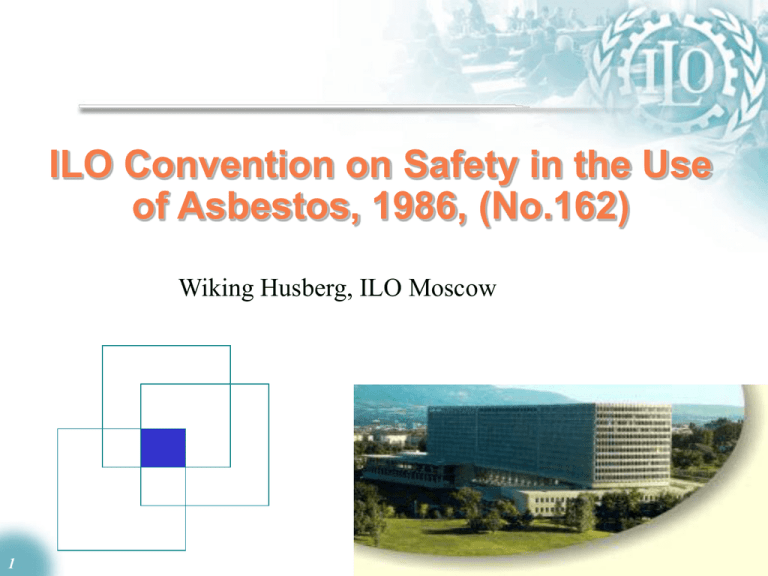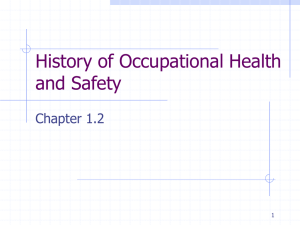Convention 162
advertisement

ILO Convention on Safety in the Use of Asbestos, 1986, (No.162) Wiking Husberg, ILO Moscow 1 ILO instruments in OSH • Legal frameworks for action: • • • • • • • • • Labour Inspection C.81 Occupational Cancer C.139 Working Environment C.148 Occupational Safety and Health C.155 Occupational Health Services C.161 Asbestos Convention 162 Chemicals Convention 170 Occupational Safety and Health Framework C 187 35 Codes of Practice A unique and formidable body of definitions, principles, obligations, duties and rights, as well as technical guidance that reflects the views of labour stakeholders 2 ASBESTOS CONVENTION • International Labour Conference, 1986, Adoption of: The Asbestos Convention (No. 162) The Asbestos Recommendation (No.172) To date, ratified by 32 countries and widely voluntary applied 3 32 Ratifications of ILO Asbestos C.162 Belgium Bolivia Bosnia and Herzegovina Brazil Cameroon Canada Chile Colombia Croatia Cyprus Denmark Ecuador Finland Germany Guatemala Japan 4 Korea Luxemburg Macedonia Montenegro Netherlands Norway Portugal Russian Federation Slovenia Spain Serbia Sweden Switzerland Uganda Uruguay Zimbabwe ASBESTOS CONVENTION 162 PART I: SCOPE and DEFINITION • Applications All activities involving workers’ exposure to asbestos in the course of work • Definitions asbestos, asbestos dust, airborne asbestos dust, respirable asbestos fibres, esposure to asbestos, workers and workers’ representatives 5 ASBESTOS CONVENTION 162 Part II: GENERAL PRINCIPLES • National Policies and Regulations • Prescription of protective, preventive and control measures • Review of laws in the light of technological progress and scientific knowledge • Responsibilities of employers and workers • System of inspection for enforcement 6 ASBESTOS CONVENTION 162 Part III: PROTECTIVE and PREVENTIVE MEASURES Prevention and control of exposure (Art.9) • adequate engineering controls, work practices occupational hygiene • prescription of special rules and procedures for use of asbestos or products containing asbestos or certain work practices 7 ASBESTOS CONVENTION 162 Part III: PROTECTIVE and PREVENTIVE MEASURES (cont’d) SPECIAL MEASURES (Art.10) When necessary to protect the health of workers and technically practicable: • replacement of asbestos by other materials scientifically evaluated as harmless or less harmful • total or partial prohibition of asbestos or asbestos containing material in certain work practices 8 ASBESTOS CONVENTION 162 Part III: PROTECTIVE and PREVENTIVE MEASURES (cont’d) • Prohibition: crocidolite, spraying all types • Notification of use of asbestos by employers • Producers’, Manufactures’ and Suppliers’ responsibilities for labelling • Prescription of exposure limits by law • Measures to prevent or control the release of asbestos dust into air 9 ASBESTOS CONVENTION 162 Part III: PROTECTIVE and PREVENTIVE MEASURES (cont’d) • When protective measures do not bring exposure within Occupational Exposure Levels, employer will provide Respiratory Protetcive Equipment and special protective clothing • Respiratory Protective Equipment to be used as supplementary, temporary, emergency or exceptional measure and not as alternative to technical control 10 ASBESTOS CONVENTION 162 Part III: PROTECTIVE and PREVENTIVE MEASURES (cont’d) DEMOLITION or REMOVAL of ASBESTOS • to be undertaken only by employers or contractors recongnized by the competent authority as qualified to carry out such works CLOTHING and WASHING FACILITIES • to be provided by the employer, cleaning carried out under controlled conditions, prohibited to be taken home 11 ASBESTOS CONVENTION 162 Part III: PROTECTIVE and PREVENTIVE MEASURES (cont’d) ASBESTOS WASTE DISPOSAL • to be disposed by employers without health risks to the workers concerned, those handling waste or to populations in the vicinity of the enterprise • appropriate measures to be taken to prevent pollution of the general environment 12 ASBESTOS CONVENTION 162 Part IV: SURVEILLANCE OF WORK ENVIRONMENT and WORKERS’ HEALTH Dust concentrations and exposure monitoring (Art. 20) Emplyer to measure concentrations of asbestos dust Employer to monitor workers’ exposure to asbestos dusts Workers’ rights to have access to exposure records Workers’ rights to request monitoring of work environment and appeal to competent authority for results Workers’ Health Monitoring (Art. 21) • periodic medical examinations • development of system of notification of ARD 13 ASBESTOS CONVENTION 162 Part V: INFORMATION and EDUCATION Govt., employers & workers organizations • should disseminate information and promote education on health hazards and methods of prevention Employers • should establish written policies and procedures for education, training and re-training Workers • should be informed, instructed in preventive measures, and receive continuing traininig 14 Руководство по системам управления охраной труда МОТ-СУОТ 2001/ILO-OSH 2001 Единственное в мире международное руководство, регламентирующее СУОТ на уровне предприятий 15 ГОСТ 12.0.230-2007 • IDT – идентичен МОТ-СУОТ 2001 • Межгосударственны й стандарт СНГ • Действует в России с 1 июля 2009 года 16 MOT-СУОТ 2001 4.10.1.Предупредительные и контролирующие меры В(а) порядке приоритетности: устранить опасности/риски (b) ограничить опасности/риски (c) минимизация опасности/риска (d) предоставить средства индивидуальной защиты P.1.1 17 СЛАЙД 6 13th Session of the Joint ILO/WHO Joint Committee on Occupational Health, 2003 18 ILO Resolution on Asbestos, 2006 “The elimination of the future use of asbestos and the identification and proper management of asbestos currently in place are the most effective means to protect workers from asbestos exposure and to prevent future asbestos-related diseases and deaths.” “The Asbestos Convention, 1986 (No. 162), should not be used to provide a justification for, or endorsement of, the continued use of asbestos.” http://www.ilo.org/public/english/protection/safework /health/resolution_on_asbestos.pdf 19 http://www.ilo.org/public/english/protection/safework/health/outline_npead.pdf http://whqlibdoc.who.int/hq/2007/WHO_SDE_PHE_07.02_eng.pdf 20 National programme for elimination of asbestos-related diseases (NPEAD) – Outline • Introduction and purpose — Health aspects — Magnitude of the problem — Economic and social aspects • Political and legal background — National legislation — International commitments • Strategy for elimination of asbestos-related diseases — Preventive strategies — Strategic actions – national, provincial and enterprise levels • Knowledge management — information about substitutes — registry of exposed workers — capacities and resources 21 National programmes for elimination of asbestos-related diseases - cont'd • Implementation — Preparatory phase – building up political commitment — First phase – reducing exposure to chrysotile — Second phase – stopping the use of chrysotile asbestos • Monitoring and evaluation — outcome — process — administration • National asbestos profile — first profile — periodic update 22 Fact sheet N°343, July 2010 Asbestos: elimination of asbestosrelated diseases • by recognizing that the most efficient way to eliminate asbestos-related diseases is to stop the use of all types of asbestos; • by providing information about solutions for replacing asbestos with safer substitutes and developing economic and technological mechanisms to stimulate its replacement; • by taking measures to prevent exposure to asbestos in place and during asbestos removal (abatement); and • by improving early diagnosis, treatment, social and medical rehabilitation of asbestos-related diseases and to establish registries of people with past and/or current exposures to asbestos. 23 The ILO position on safety in the use of asbestos, Sept 2010 4. A Resolution concerning asbestos was adopted by the International Labour Conference at its 95th Session in 2006. Noting that all forms of asbestos, including chrysotile, are classified as human carcinogens by the International Agency for Research on Cancer (IARC),… 24 The ILO position on safety in the use of asbestos, Sept 2010 …The Resolution also underlined that the ILO Convention on Safety in the Use of Asbestos, No. 162, should not be used to provide a justification for, or endorsement of, the continued use of asbestos. 25 The ILO position on safety in the use of asbestos, Sept 2010 In light of the instructions of the Governing Body following the Resolution, the Office has been: • continuing to encourage member States to ratify and give effect to Conventions Nos. 162 and 139; • promoting the elimination of the future use of all forms of asbestos and asbestos-containing materials; • promoting the identification and proper management of all forms of asbestos currently in place; and • encouraging and helping ILO member States to include measures in their national programmes on occupational safety and health to protect workers from exposure to asbestos. 26 Премьер-министр Владимир Путин об охране труда Особое внимание Владимир Путин обратил на необходимость увеличения расходов на охрану труда. «Легче и дешевле вкладывать деньги в обеспечение безопасности труда, чем в ликвидацию последствий тех трагедий, которые могут произойти или происходят в результате невнимательного отношения к этим проблемам» (из выступления на встрече с представителями профсоюзных организаций Ленинградской области 7 октября 2010 г.) 27







